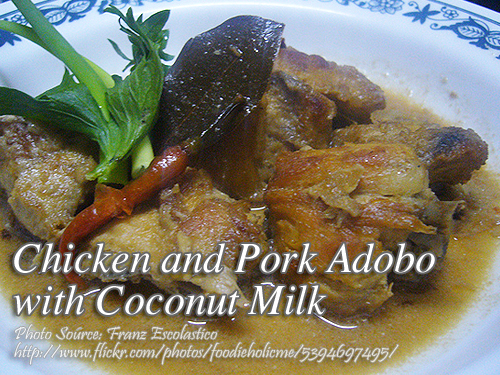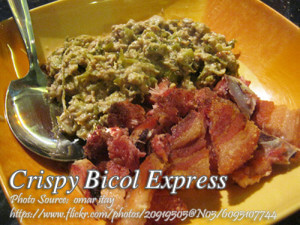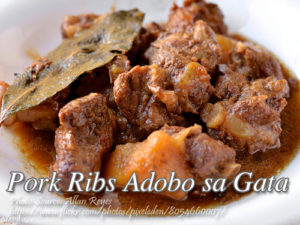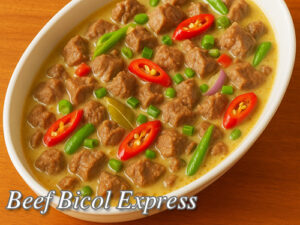Want something new cooking chicken or pork adobo? Then spice up your cooking with this chicken and pork adobo sa gata. Adobo usually contains soy sauce and vinegar but this recipe replaced them with coconut milk, vinegar and salt. If you haven’t tried this recipe yet, then I think this is a good addition your menu the next time you plan your cooking.
Chicken and Pork Adobo sa Gata: A Taste of Home: Our Family’s Twist on Adobo
Growing up in Bicol, our kitchen always smelled like garlic frying in oil and something rich bubbling on the stove. One of the dishes that never failed to bring everyone to the table was this creamy, savory chicken and pork adobo sa gata. It wasn’t the typical soy sauce-based adobo most Filipinos know. Instead, this version used coconut milk, a staple in many Bicolano households, and relied on salt and vinegar to draw out deep, comforting flavors.
I first learned this recipe from my Uncle Lando, who swore by the magic of slow-simmered gata. He’d always say, “Wag mong madaliin ang gata, hayaan mong lambingin ang karne.” And he was right—there’s something transformative about letting pork and chicken soak up that rich coconut flavor.
Why This Adobo Recipe Works
Unlike traditional adobo, which uses soy sauce for its signature dark color and umami, this version gets its depth from the combination of vinegar and coconut milk. The acidity of the vinegar tenderizes the meat, while the coconut milk adds a creamy finish that balances the sourness. Skipping soy sauce might seem odd at first, but once you taste the final dish, you’ll understand how well this blend works.
The initial step of boiling the meat with vinegar and spices helps eliminate the raw smell while locking in flavor. My cousin Mila, who’s now based in Laguna, says this is their trick to making the dish taste even better the next day. After draining the broth, we pan-fry the meat to give it a slightly crispy edge—this adds texture and helps seal the juices before we add the coconut milk back in.
How to Cook Chicken and Pork Adobo sa Gata
Start by cutting your pork and chicken into small, manageable pieces. We usually go with a mix of pork belly and bone-in chicken parts for that extra flavor. In a pan, combine your meat with vinegar, garlic, peppercorn, salt and MSG and a bit of water. Skip the soy sauce—this recipe is all about the balance of tang and cream. Bring everything to a boil and let it simmer for about five minutes.
Drain the broth and set it aside—don’t throw it out, we’ll need it later. Heat oil in a pan and fry the meat along with some garlic until it gets a nice golden color. This step is crucial because it enhances the overall flavor of the dish. Once the meat has browned slightly, pour back the reserved broth, cover the pan, and let it boil.
When the meat is halfway cooked, it’s time to introduce the coconut milk. Stir gently and bring it to a boil. Season with salt (and MSG, if you prefer—it really brings out the umami). Let it simmer until the pork and chicken are tender and the sauce is thick and creamy.
A Comfort Food With Deep Roots
Adobo is often seen as the national dish of the Philippines, with countless regional versions. The version with coconut milk, or “adobo sa gata,” is especially popular in southern Luzon provinces like Bicol and Quezon, where coconut trees are abundant. Adding gata isn’t just about taste—it reflects how Filipinos adapt dishes based on what’s locally available. It’s a beautiful example of how food evolves with the environment.
When my sister Liza visited Camarines Sur last year, she came back raving about a roadside karinderya that served the best pork adobo in coconut milk she ever had. She asked for the recipe, and the cook simply smiled and said, “Lutuin mo lang ng may pagmamahal.”
That’s what this dish is for me—a memory simmered in coconut, made richer by every bite.
Try This Easy Chicken and Pork Adobo With Coconut Milk
If you’re new to cooking, this is a great starter dish. You don’t need fancy ingredients or complicated techniques. Just patience and a good pot. The result is a hearty, creamy, and slightly tangy stew that pairs perfectly with a mound of steaming rice.
So the next time you’re planning your weekly menu and feel like the usual adobo is getting old, give this creamy version a try. It’s a dish full of soul and history—and trust me, one bite will bring you back to the warmth of a Filipino kitchen, even if it’s your first time making it.
How to Cook Chicken and Pork Adobo sa Gata
Ingredients
- 1/2 kilo pork cut into serving pieces
- 1/2 kilo chicken cut into serving pieces
- 1 cup vinegar
- 2 Tbsp. salt
- 1 tsp. MSG
- 1/2 tsp. pepper powdered
- 5 to 6 cloves garlic minced
- 2 cups thick coconut milk
Instructions
How to cook Chicken and Pork Adobo sa Gata:
- Cut pork and chicken into small serving pieces.
- Put in pan and add all ingredients: vinegar, salt, pepper, MSG, crushed garlic except coconut milk.
- Boil for 5 minutes. Drain. Set aside broth.
- Fry pork, chicken, and garlic in cooking oil until a little brown, drain the oil and leave about 2 tablespoon of oil. Add broth again, cover and boil.
- When half cooked, pour in coconut milk. Stir until it boils. Season with salt and MSG.
- Continue cooking until pork and chicken are done.
Notes
Cooking Tips:
Let the Vinegar Boil Before Stirring
When you add vinegar to the pot, resist the urge to stir right away. Let it boil uncovered for a few minutes to allow the sharp acidity to mellow out. This technique prevents the adobo from tasting too sour and helps balance the overall flavor.Brown the Meat for Depth of Flavor
After the initial boil, lightly frying the pork and chicken before adding the broth back creates a deeper, more complex taste. The browning process caramelizes the surface and locks in juices. This step enhances the savory profile of the dish and pairs beautifully with the creamy coconut sauce.Simmer the Coconut Milk Slowly
When you add the gata, lower the heat and let it simmer gently. Avoid boiling too hard, as this can cause the coconut milk to curdle or separate. A slow simmer helps the sauce thicken naturally while keeping it silky and rich.






Hi, thanks for sharing this adobo sa gata recipe!
Hi Gwen, you are welcome! Thank you also for sharing your thoughts!